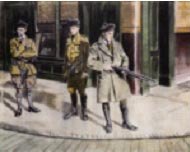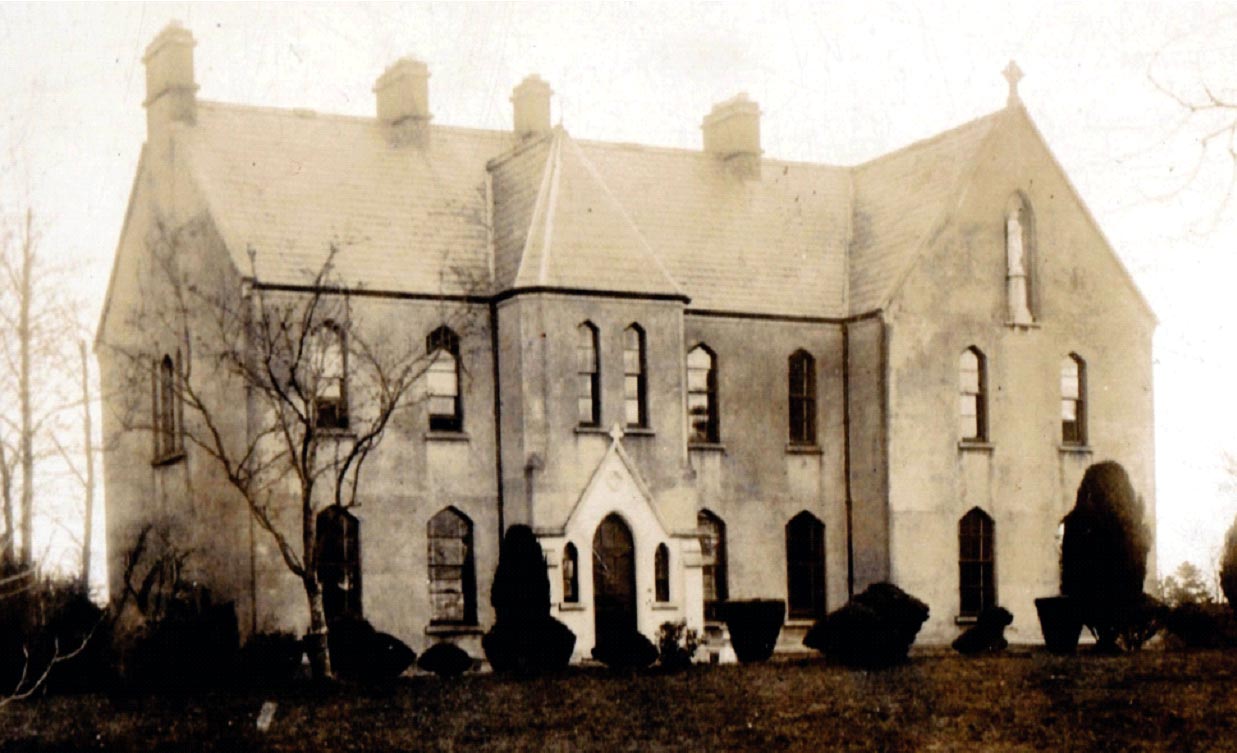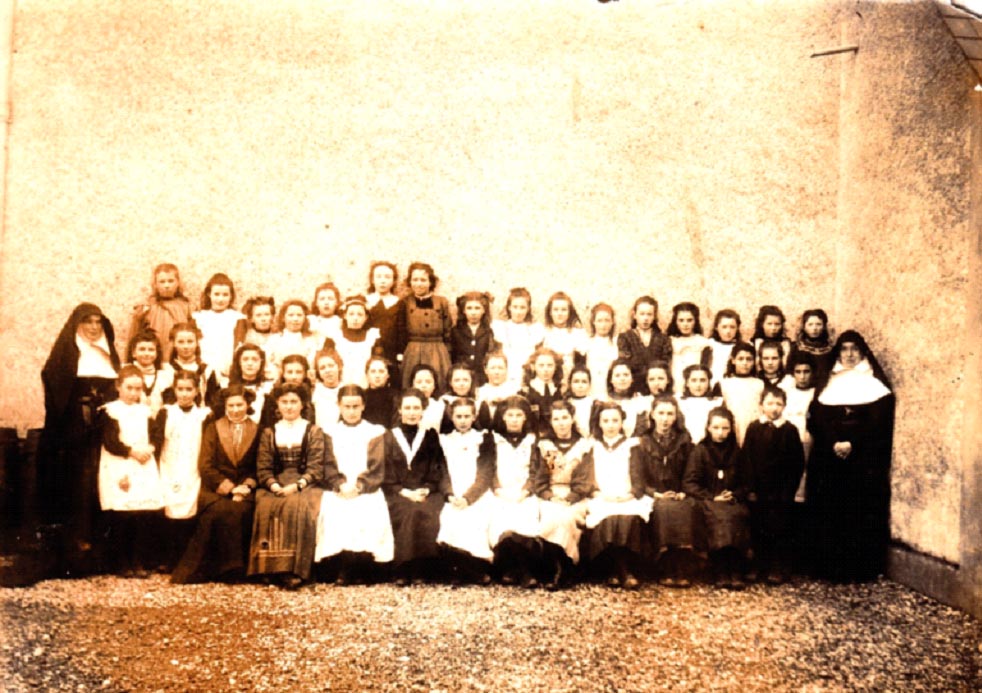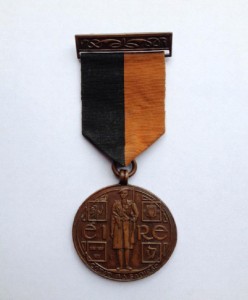When the Black and Tans came calling to our school, 1920–1
Published in Decade of Centenaries, Features, Issue 5 (September/October 2015), Volume 23‘If a police barracks is burned or if the barracks already occupied is not suitable, then the best house in the locality is to be commandeered, the occupants thrown into the gutter. Let them die there—the more the merrier. Should the order not be immediately obeyed, shoot and shoot with effect. If the persons approaching carry their hands in their pockets, or are in any way suspicious-looking, shoot them down. You may make mistakes occasionally and innocent persons may be shot, but that cannot be helped, and you are bound to get the right parties some time. The more you shoot, the better I will like you, and I assure you no policeman will get into trouble for shooting any man.’

The Black and Tans—brought into Ireland in 1920 to assist the armed police force, the Royal Irish Constabulary. (Mick O’Dea)
These were the orders given in June 1920 by Lt. Col. Gerald Brice Ferguson Smyth, a one-armed veteran of the Great War and Royal Irish Constabulary (RIC) divisional commander for Munster. In Rochfortbridge, Co. Westmeath, ‘the best house in the locality’ was the Convent of Mercy, attached to our school, St Joseph’s.
Convent of Mercy annals
The annals of the convent for the years 1920–1 reveal a number of disturbing incidents relating to the Black and Tans, and in particular their efforts to commandeer the convent. The annals were handwritten yearly accounts or diaries of life in the convent and of local and national events of the day. Each year the bishop of Meath visited and would read and sign the annals as an accurate portrayal of life in the convent. Fortunately, none of Lt. Col. Smyth’s scenarios were ever played out to their chilling conclusions, but one certainly detects an air of concern, uncertainty and no little prayer in the annals of these troubled days.

The Black and Tans
According to D.M. Leeson, ‘the Black and Tans were … unemployed ex-servicemen in post-war Britain—young men with both military training and combat experience’, who were to assist the RIC in Ireland. The idea came from Winston Churchill, secretary of state at the War Office. The advertised wage of 10s. a day and all found was a princely sum in the troubled and hungry ’20s. As there were not enough dark green RIC uniforms to clothe them, they appeared in what Richard Bennett described as a ‘strange medley of khaki and dark green, some with civilian hats, but most with the green caps and black leather belts of the RIC’.
Of much more concern to us, however, is the fact that their morale had not been improved by months of unemployment since the end of the war and that the RIC officers under whom they served had no great powers of military discipline over them. The popular notion that they were mostly jailbirds, while good propaganda, does not reflect the reality. From early January 1919 to the end of December 1922, 9,762 men were recruited under this category, most of them ex-servicemen from the greater London area. Interestingly, five Irish-born Black and Tans came from County Westmeath. Nonetheless, there can be no doubt that on arriving in Ireland the Black and Tans became notorious for their attacks on civilians and civilian property.
What the convent annals say
It was from our study of the annals of the convent that we gained our deepest insights into the atmosphere that prevailed in the war-torn Ireland of 1920–1. For example, we read of instances where ‘the Black and Tans were guilty of great cruelty … many were shot without any reason and many more imprisoned without cause … lorry loads of Black and Tans with rifles were constantly passing and many shots were fired’. We read of impending dangers and forebodings: ‘on a few occasions the Sisters who were in the grounds narrowly escaped being hit by bullets, and often shots were fired from the Barracks and every light sent out’; or ‘The Sisters in St Joseph’s were terrified one night, a number of lorries stopped in the village and some of the Black & Tans came to the door and hammered on it to get in’. This seems to have happened on more than one occasion.
One of those present and honourably noted during these frightening ‘inspections’ was Fr Kelly: ‘Fr Kelly very kindly came along and allowed them to stay in the parochial house. They left next day after a fruitless search.’ This seems to suggest that Fr Kelly’s intervention on that particular occasion could have prevented a more serious incident from taking place.
On another occasion a certain Colonel Cooper came to our attention and he became a very interesting character in our story, as we found that he had quite a distinguished career with the British Army. During a Black and Tan round-up of the district while ‘searching for IRA who were wanted … Colonel Cooper, a retired British officer, and his wife were in the neighbourhood, and had to remain with all the others’. It seems quite ironic that he should have been ‘on the other end’ of a Black and Tan round-up within our community and school, the Black and Tans hardly realising at the time that they had ‘captured’ a retired major-general of the Royal Fusiliers, City of London Regiment!
These searches were carried out in the wider parish: ‘Many houses in the parish were raided and four parishioners were imprisoned in a tiny cell in the barracks for a considerable time. We supplied a dinner to them each day. Revd Mother spoke to Dr Keelan about their condition … Things were so bad that the bishops issued a statement setting forth some of the atrocities committed.’
As 1920 wore on, the Black and Tans began to use the tactic of destroying property as reprisal for IRA actions. An example was the killing of Col. Cmdt. Lambert and the wife of Col. Challoner as they travelled through Glasson, Co. Westmeath. It is believed that the original intention of the IRA men was to hold the passengers hostage to bargain for the release of the leader of the Longford IRA, and that the deaths were ‘accidental’. The Black and Tans retaliated by burning five farmhouses in Coosan, before moving on to Mount Temple to burn the home of Anne Heavey, whose son was a member of the IRA. The IRA reacted by burning Moydrum Castle, with one of the raiders, who were dressed in ‘civilian attire’, even telling Lady Castlemaine, who was at home at the time, ‘We are burning your house as a reprisal for the recent burnings at Coosan and Mount Temple’.
In 1917–21 there were eighteen fatalities in County Westmeath, including IRA members, policemen, civilians and soldiers. The impact of these events on this community and our school cannot be underestimated and leaves one with a deeper understanding and appreciation of what life was like in the Ireland of 1919–21. That these incidents happened in some of the places with which we are familiar and can see every day makes it much easier to imagine how difficult and different life was, both in the village and for the sisters, during those years.
Unanswered questions
This study has also left us with a number of unanswered questions and with a lot of food for thought, particularly concerning the main characters in this story. What if Col. Cooper and his wife had not been in Rochfortbridge on the night of the round-up in the locality? Would their absence have led to a more serious incident? What if Fr James Kelly, the local parish priest, had not offered the Black and Tans accommodation in the parochial house, thus saving the nuns from an uncertain future? What if Dr Keelan had not intervened on the part of the four prisoners held captive in the local RIC barracks in Rochfortbridge? Did he save their lives by making a complaint to the military authorities, who later had them transferred to Athlone? Perhaps British writer and historian Bertrand Russell (1872–1970) summed it up best in observing that ‘war does not determine who is right—only who is left’.
So what of those who were ‘left’ in this story? Col. Smyth, who had advocated a ‘shoot-on-sight’ policy in June 1920, did not have long to live. His instructions marked him out for attention from the IRA. While in Cork the following month, he took lodgings at the Cork and County Club, an Anglo-Irish social club. On the evening of 17 July 1920, he was in the smoking room of this club when a six-man IRA team entered and said: ‘Colonel, were not your orders to shoot on sight? Well, you are in sight now, so prepare.’ Col. Smyth jumped to his feet; his
struggle was but a short one. He was 34 years old. The Coopers eventually sold their lands and estate at Dunboden and moved to England. Fr James Kelly, parish priest of Rochfortbridge, died shortly after these incidents had taken place in February 1921; in the annals his passing was greatly mourned by the nuns, who regarded him as ‘a great priest and a wonderful preacher’. Dr P.J. Keelan remained on as a well-liked and respected GP in the Mullingar area for many years afterwards until his retirement in the mid-1950s. The Sisters of Mercy in Rochfortbridge remain there to this day, and their determination in the face of adversity during those bygone Black and Tan raids of 1920–1 serves as a reminder that the school ‘inspections’ of the future may not be as daunting as those that were carried out in the past.
Rochfortbridge Convent of Mercy

On 21 August 1862, Sr Gertrude Dunne (superior), Sr Stanislaus O’Neill and Sr Magdalene Hackett left Tullamore to found a convent in Rochfortbridge. According to a 2012 publication to mark its 150th anniversary, To serve with gladness, ‘the village of Rochfortbridge was peculiarly Protestant and had a large percentage of admirers of William of Orange. Many a lively skirmish took place between the “Orange” and the “Green”.’ Interestingly, Eliza Fielding, a local Protestant girl, joined the Order of Mercy in Tullamore in 1861, taking the name Sister (later Mother) Mary Paul, and returned to Rochfortbridge in 1864.
Westmeath during the War of Independence

Cogadh na Saoirse medal.
In 1918 there had been 32 RIC barracks in County Westmeath. By the time of the truce in July 1921 that figure had been halved to sixteen, leaving large areas of the county unpoliced. For policing purposes, the county was divided into four districts: Mullingar (including Rochfortbridge), Athlone, Castlepollard and Moate. Apart from hotbeds of activity—Kilbeggan, Moate, Castlepollard, Mullingar and Athlone—most of the county was satisfied with minor acts of defiance. But there is no doubt that Sinn Féin had widespread support throughout the county and that an anti-British feeling was prevalent.
DECADE OF CENTENARIES
ALL-ISLAND SCHOOLS’ HISTORY COMPETITION 2016
This competition for primary and post-primary schools is sponsored by the Department of Education and Skills, Mercier Press, UCC School of History and History Ireland. There are four categories: ‘decade of centenaries’; biography; local or regional issues; and national issues. There will be prizes for the best primary and post-primary project in each category, one of which will be considered for publication in the Sept./Oct. 2016 issue of History Ireland, and a year’s subscription to the magazine. A project can be submitted by a class, a group of students or an individual student. Maximum word count is 2,000 for primary and 4,000 for post-primary. Closing date for receipt of completed projects is 1 April 2016. Winners will be announced and prizes awarded before the end of May 2016.
Further information @ education.ie/historycompetition.
The Royal Irish Constabulary
The RIC was the armed police force in Ireland that served here from 1836 until 1922. We noted with some interest that according to the census returns of 1901 and 1911 the RIC barracks at Rochfortbridge was policed by Irish-born officers. In 1901 the number of officers in Rochfortbridge was given as six but by 1911 this had been reduced to two. Interestingly, the census return forms (Form H) for military and RIC in barracks were designed so as not to reveal the identity of the officers, as only the initials of each officer were required. These returns also show that the officers came from all over Ireland and were for the most part Roman Catholic. In the census column to be filled out under ‘particular profession, trade or other employment before enlistment or appointment’, most stated that they were ‘farmer’s sons’.
Below: The 1901 census form (H) of Rochfortbridge’s six RIC officers. By 1911 there were only two. (NAI)
Further reading
D. Dunne, To serve with gladness: celebrating 150 years of the Sisters of Mercy, Rochfortbridge (Longford, 2012).
D. Fitzpatrick, Terror in Ireland 1916–1923 (Dublin, 2012).
D.M. Leeson, The Black and Tans (Oxford, 2012).
W.J. Lowe, ‘Who were the Black-and-Tans?’, History Ireland 12 (3) (Autumn 2004).
















